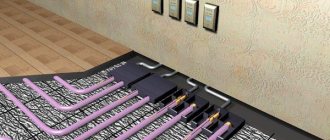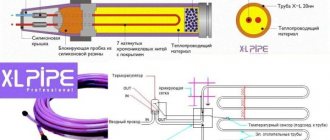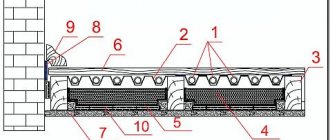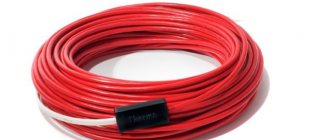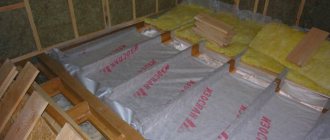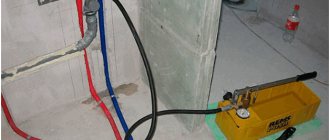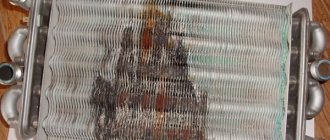When choosing the type of heated floor heating, you have to decide: to install a water or electric heated floor. Electric is easier to install, but expensive to operate. You have to pay a little for water every month, but its installation is complicated and very expensive (if you also install a boiler, mixing unit, and manifold). But today there is a symbiosis of both systems, combining the advantages of both systems: water (liquid) electric heated floor. By the way, this is the only option for a water heated floor without a pump; in any other version the system will not work. There are two offers on the market today:
- From the Korean campaign Daewoo Enertec. Her product is called XL Pipe (XL Pipe).
- The UNIMAT AQUA capillary floor is from another fairly famous Korean campaign, Caleo, but you need to take into account that the products of the Russian branch of this campaign are sold in our country.
The systems are identical only in that pipes filled with liquid are hidden in the screed, and that the coolant is heated by electricity. But the heating elements themselves and the method of heating the liquid are different. Read more about each of the systems below.
Technical features of XL Pipe underfloor heating
The difference between the system is that the cable is located in a pipe filled with liquid, which heats up and transfers heat.
The newest XL PIPE floor system consists of sealed plastic pipes with an electrical cable inside them. The pipes are filled with a special liquid that quickly boils when the cable is heated.
XL PIPE can be used as main and additional heating. You don't need a boiler or furnace to install it. Thanks to this, installation of an electric water floor requires minimal financial investment.
This type of underfloor heating can be used in small cold areas and in large rooms. It fits into a screed up to 8 centimeters. The lining can be hard or soft. In contrast to this system, electric underfloor heating only requires solid facing material.
Water floors: installation and operation features
Water floors are an economical type of heating due to the use of water as a coolant. After installing them, you don’t need to think about where to put the furniture. There will be no radiators on the walls, floors with a water circuit are not afraid of heavy interior items.
The main distinguishing feature of water floors is the difficulty in connecting them. For example, to install water heated floors in an apartment, you need a document confirming the consent of the management company to connect to central heating.
When the heating is individual, it is necessary to install a unit for heating the coolant. This means that all the difficulties associated with installing and servicing a boiler are added: gas, electric, solid or liquid fuel. You need to allocate a specific place for its installation, and at the same time comply with all the rules and regulations.
Installing a water circuit for a heated floor requires a lot of preparatory work. This is a rather labor-intensive process that requires attentiveness and professionalism, because in the event of a leak, you will have to open the entire finishing coating of the room.
Laying under furniture
Suppose you have a large closet with a blind base along the entire wall in your room. Naturally, there is no air circulation under it, which means there is no heat removal in this place.
An ordinary electric heated floor in such a situation will simply overheat and burn out. Therefore, when installing it, it is recommended to avoid furniture in every possible way.
But the electric-water analogue, according to advertising brochures, can be placed under furniture.
But what do the instructions tell us again, and not the advertising? And the instructions contain several points that clearly state that this type of heating is afraid of overheating and should not be allowed to occur!
That is, the manufacturer directly prohibits you from placing the pipe in conditions where overheating is possible. Sales people say the opposite.
And who to believe here?
Advantages and disadvantages of use
Liquid heated floors are a heating device powered by an electrical network. The design includes a cable that, when heated, transfers heat to the coolant in the pipes.
Combined equipment has many advantages over water and electrical systems:
- ensuring completely uniform heating;
- ease of circuit installation;
- no need to connect to the boiler;
- ensuring a working process without using a pump;
- avoiding cable overheating during system operation;
- simple process of replacing damaged areas;
- Possibility of installation in rooms with high humidity levels;
- does not require installation of collector units;
- complete safety of use;
- low electrical energy consumption;
- automatic control process.
What does an electric water heated floor look like?
An electric water heated floor warms up completely in a few minutes. At the same time, the duration of the heating effect is much longer than that of other types of heating systems.
There are no disadvantages of using a liquid device for floor heating yet. The only disadvantages include the high cost of the equipment.
conclusions
In modern conditions, you can quite successfully equip your house, apartment or other household premises with a fairly efficient heating system on your own. Warm floors have already proven in practice their effectiveness, efficiency and convenience. Liquid underfloor heating systems using electricity take such systems to a whole new level. The principle applies here: less hassle, more comfort. It is up to you to choose what to install at home, a water heating system or give preference to liquid electric heating devices.
Unimat Boost
The Unimat Boost heating system differs from the Rail modification. It is also represented by mats with heating rods. The filler consists of carbon, silver and graphite. The rods are reinforced in 10 cm increments.
A distinctive feature is that the system is a self-regulating device. If one of the rods overheats or breaks, heating does not stop. The energy is distributed across all elements of the Unimat heated floor. Power 1 linear m is 138 W.
Warm floors “Unimat Boost” are laid in a deep screed or under tile adhesive with a layer thickness of up to 5 cm: such a voluminous layer does not affect the heating efficiency. Installation can be done in rooms with any temperature and humidity conditions. The rods are reliably protected by insulating material, which protects the heating element from moisture.
They purchase “boost” warm floors from dealers in Moscow and St. Petersburg. The manufacturer provides a long warranty on the heating system, up to 10 years. The service life is up to 50 years. If individual rods break, they can be easily replaced with new elements.
Life time
The declared service life of the system is more than 50 years!
A logical question arises: where did this come from and how was it calculated? Most likely, the information was obtained based on the fact that any manufacturer of polymer materials (pipes) automatically provides 50 years of trouble-free operation for its products (subject to operating temperature).
What if there is a liquid leak or a malfunction of the thermostat? And this can easily happen due to a power surge.
What will your pipes turn into after uncontrolled heating?
That is, here initially you need to take into account several factors, and not just the material of manufacture and its factory service life.
Secondly, do not forget that there is a thermal expansion compensator inside the pipe. Who calculated how long he would work?
Thirdly, it is unknown how the chemical composition of the non-freezing liquid will affect the properties of the tube walls. The properties of the antifreeze itself also change over the years.
This means that it will have to be drained and refilled somehow. No one usually tells you about these nuances.
You just have to BELIEVE in the beautiful number 50.
Unimat Aqua
Warm floor "Unimat Aqua" is a liquid circuit. Water is used as the liquid. It does not circulate in the system from the boiler and back. The liquid is constantly in the pipeline. Inside the pipes there is a heating cable that operates from a 220 V network. When the cable is heated, thermal energy is transferred to water, which in turn gives off heat to the floor covering.
Unimat Aqua underfloor heating does not require a traditional water heating system. There is no need to install a boiler with a mains for hot and cold water. The hydronic underfloor heating system is powered by electricity.
The main line is placed on the floor in a “snail” or “snake”. Both ends of the cable lead into the junction box and into the thermostat. To control the temperature, a sensor is installed on the floor. All conductors are insulated and led out using a probe into a corrugated tube. She runs the cables to the thermostat.
The maximum liquid temperature is 70 0C. It is recommended to set the mode to 50 0C. At the same time, the air temperature in the room is maintained at 25 0C. The power of the system depends on the length of the pipe. To heat small rooms you will need a power of 130 W. For cold rooms, warm floors of 200 W are installed.
offers various modifications of underfloor heating systems. In order to maintain a certain floor temperature in a room with central heating, heating mats are used. For large rooms, it is recommended to install a line with a coolant liquid as the main heat source.
YouTube responded with an error: The request cannot be completed because you have exceeded your quota.
Types of system. Device and principle of operation
Today on the heating equipment market in the underfloor heating segment, two models are presented:
- products of the Korean company Daewoo Enertec, warm water electric floors XL Pipe (XL Pipe);
- a product of the Korean company Caleo, capillary heated electric floor UNIMAT AQUA.
The latter option has domestic analogues, which are produced under license at Russian enterprises.
Both the first heating system and the second have some differences in the design and principle of operation of the heating elements, although everything else, both installation and principle of operation, are absolutely the same.
Warm electric water floors XL Pipe
Let's consider what is special about the design of a heating system using electricity. For a first acquaintance, let's take the heating system, electric water heated floors XL Pipe (XL Pipe). What is new in this case is the structure of the heating element itself. The base of a polyethylene pipe (walls 20 mm thick) is laid with a heating cable along its entire length. The important thing is that this is not a simple cable, but woven nickel-chrome threads enclosed in a Teflon sheath. The rest of the internal space of the plastic pipe is filled with liquid coolant, which is in a static state. The pipe is a hermetically sealed single circuit.
Obviously, in this case you don't need either a pump or a manifold. The diagram clearly shows the internal structure of the heating circuit, the appearance of the plastic pipe and an approximate layout of the XL Pipe electric water floor.
The coolant in this case is antifreeze, so the system should correctly be called an electro-liquid heated floor. Using thermal energy from heating the electrical element, the coolant is evenly heated along the entire length of the heating circuit.
The operating principle of the underfloor heating system in this case is based on the interaction of the heating element with temperature control sensors. The thermostat is one of the main devices for any heating system, so in this case you cannot do without it.
Electric water heated floors operate according to the following principle:
- The first is getting involved in work. The power provides heating to the electrical cable, which in turn heats the coolant surrounding it.
- The second is the expansion of the heated coolant. Due to the fact that the volume of liquid is small and the power of the cable is large, heating occurs intensively.
- The third is an increase in the volume of heated liquid, thereby creating increased pressure inside the plastic pipe (nucleate boiling).
- Fourth – quick access of the heated floor to operating heating modes.
Here it is worth saying a little about the costs of operating an electrical element associated with heating the coolant. Energy consumption in this case is 14.4 -15 W per square meter. meter of underfloor heating, which is significantly lower than what is required when operating conventional electric floors. Due to the coolant fluid, even a switched-off heated floor cools down two or three times slower than a cable heating system.
Capillary warm electric floor
It is better to install such a heating system through connecting an RCD and equipping the entire complex with an automatic device.
This combined floor heating system is designed for heating small spaces. The system can be installed in rooms whose area does not exceed 20 m2.
The advantages of the capillary heating system are as follows:
- wide functionality of the heating block;
- the presence of an antifreeze mode;
- automatic control of the heating temperature of the coolant depending on the indoor temperature;
- adjustment of the power of the heating device in the range of 0.1 - 2.4 kW.
- presence of a timer.
Retains heat longer
Since there is a coolant inside the pipe, the entire system supposedly retains heat better than a conventional heating cable under a screed.
Specifically, two hours longer. For simple heated floors this time is 2 hours, for electro-fluid floors – 4 hours.
That is, so that you understand, the surface area of the floor does not change in any way, nor does the material and thickness of the screed.
The cable in the pipe gives off heat to the screed; a regular heating cable without a pipe also gives off heat to the screed.
In both cases, the floor warms up exactly the same. And only by adding liquid to the tube, in some magical way the indicators should change several times.
Roughly speaking, you gave the liquid 1 kW of heat and what should it do with it? Transfer to the floor or save, or maybe save 1 kW and transfer 1 kW?
What a miracle system with an efficiency of 200%!
When a room with its heat loss conditionally needs 1 kW/h of thermal energy to maintain 25C, then it makes absolutely no difference where you get this kW (gas, electricity, solid fuel) and how you transfer it - by convection or infrared radiation, underfloor heating, water or electric, fireplace, radiators or heat gun!
If you take a d-20mm pipe (2.5mm thick) and calculate the total volume of coolant inside it, for a standard length of an electro-fluid system of 56 meters, you get approximately 10 liters.
As an experiment, place a bucket of water heated to 40 degrees in the room and let it cool to 20 degrees.
Even one domestic cat with its stable body temperature of 38-39C will bring much more warmth into your home
